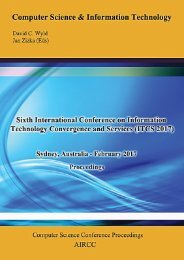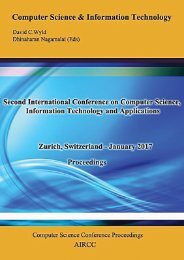CoSIT 2017
Fourth International Conference on Computer Science and Information Technology ( CoSIT 2017 ), Geneva, Switzerland - March 2017
Fourth International Conference on Computer Science and Information Technology ( CoSIT 2017 ), Geneva, Switzerland - March 2017
You also want an ePaper? Increase the reach of your titles
YUMPU automatically turns print PDFs into web optimized ePapers that Google loves.
120 Computer Science & Information Technology (CS & IT)<br />
We used SVMRank to learn the model and considered three queries. We used the Arnetminer’s<br />
evaluation dataset comprising of seven queries. For each query, we labeled experts list with 1,<br />
and complemented it with equivalent number of non-experts (labeled as 0), containing easy and<br />
hard examples. Researchers’ feature vectors undergone some preprocessing as well by removing<br />
the null and conflicted ones and finally normalizing them.<br />
4.2. Results & Evaluation<br />
Table 1 shows the learned model comprising of the features’ weights. The obtained results reveal<br />
that conference committee memberships has the biggest impact among all other features, for<br />
experts are members of committees just for they have the required expertise. Another high<br />
influential information is the h-index, because it represents the scientific impact of his<br />
publications on other scholars, it also signifies his productivity. The relation between query and<br />
author through author-topic model is significant as well, because this value is based on the<br />
author’s publications, the more he is assigned to query topic-related words in his publications, the<br />
more he is likely one of the experts on the query topic. As for conference ranks, the other<br />
introduced criterion, showed that it does influence the scholar’s expertise but not in same degrees<br />
as the previous ones. Even the number of publications has not a very big impact, because it’s not<br />
always about the quantity of publications, it’s more about the quality. The weight for number of<br />
citations has a negative impact, even though the h-index had the opposite case. Well, this is<br />
because two scholars might have the same total number of citations, but the way they are<br />
distributed over their publications may vary (number of publications may vary too) and when that<br />
happens, the h-index varies as well. The number of publications in recent years (2009 and above)<br />
showed that it’s not important for a person to have published a lot of papers in the recent 6 years,<br />
the whole career counts more than these last years. I10-index’s weight is the smallest one, and it<br />
is that way perhaps because h-index almost contains the i10-index concept, and the former highly<br />
influences the expertise.<br />
Table 1. Features Weights<br />
Feature<br />
Weight<br />
# of pubs 0.810033<br />
# of recent pubs -1.703149<br />
# of citations -0.440943<br />
H-index 3.464950<br />
I10-index -1.323053<br />
Conference ranks 1.118827<br />
Author-topic model 2.461189<br />
Conference committee 4.592299<br />
For the evaluation, we used Arnetminer’s new dataset (7 queries). Precision at 5, 10, 15, 20<br />
(P@5, P@10, P@15, P@20) and the Mean Average Precision (MAP) are the considered<br />
evaluation metrics. Tests were done on two approaches, a baseline approach and our approach<br />
where our approach = baseline + {conference rank, conference committee}. The figures 2, 3 and<br />
4 below show the performance of the baseline approach and our approach in Information<br />
Extraction, Machine Learning and Intelligent Agents respectively.<br />
In figure 3, we can clearly see the gap between the two approaches. When n was 5, the baseline<br />
precision was very low (20%), whereas that of our approach was 60%. Even though when n





